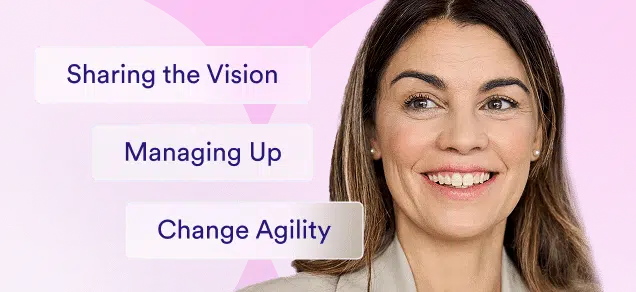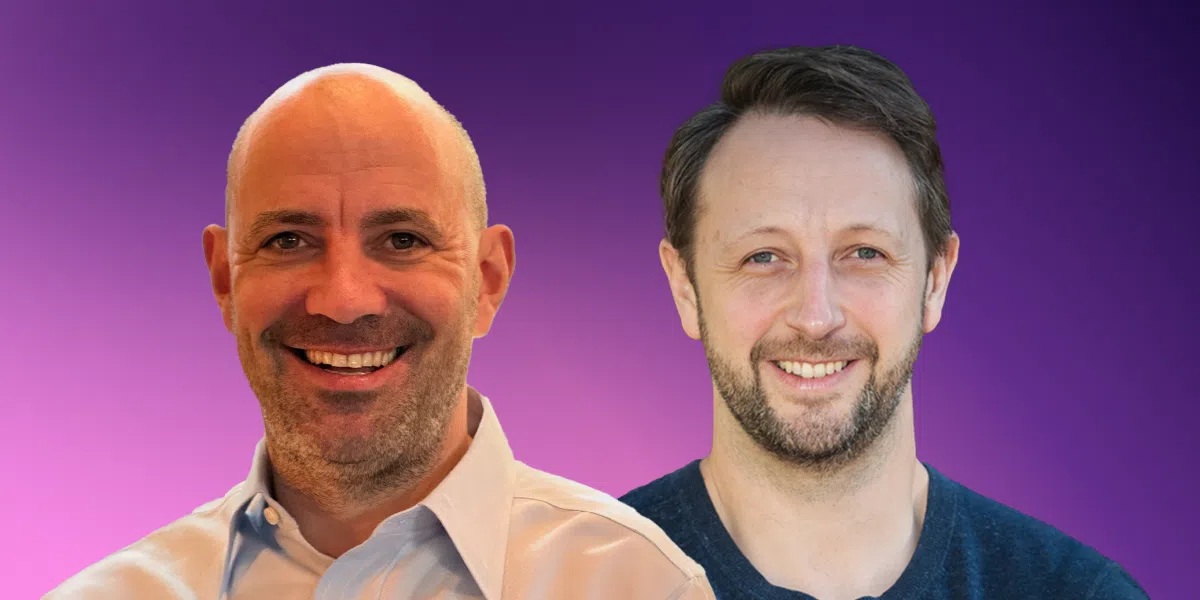Below is a transcript from the recent session at Forward. Prefer to watch the recording? Click here.
Rea Rotholz: Welcome to Forward: Upskilling and Performance in the Age of AI. I’m Rea Rotholz, Senior Director of Learning Solutions here at Hone, and I am so excited to be your host today.
We’re thrilled to bring together nearly 2000 HR and L&D leaders from around the world for what’s truly going to be an impactful day of learning, insights, and connection.
I am super happy to introduce our first session today, Beyond the Hype: How AI is Driving Workforce Transformation Today. To guide us through the session, I’m thrilled to hand it over to two incredible leaders, and I will quickly read their bios so we can learn a little bit more about them.
First, Markus Bernhardt, a strategic advisor who equips senior leaders with evidence-based frameworks to execute workforce transformations with confidence. Drawing on research from his acclaimed Endeavor Report and his 360-view of the technology ecosystem, Markus helps organizations build future-ready, human-centered workplaces where talent thrives.
And joining him is Tom Griffiths, Co-founder and CEO of Hone. Prior to launching Hone in 2018, Tom was the Chief Product Officer and Co-founder of FanDuel, where he helped grow the company to over 6 million users and establish it as a household name in sports. His experience at FanDuel revealed a critical gap—and I’ve heard him share this story many times—development opportunities were reserved for the select few, usually the most high up, leaving most employees lacking those same development opportunities. Driven to democratize executive-quality training for all, Tom co-founded Hone to empower organizations everywhere to build stronger, high-performing teams.
Together Tom and Markus will set the stage for our entire day with a myth-busting reality check conversation based on what’s hype, what’s real, and what’s next for HR and L&D in the age of AI. So with that, Tom, Markus, the floor is yours.
Tom Griffiths: Thank you Rea. Thank you Markus for joining us, and thank you all of you for being here for some great conversations over the next few hours at Forward.
We really wanted to put on a fantastic slate of panels and conversations to cut through what’s happening right now. And understand and arm you with the tools, techniques, and frameworks that you need to go and do a successful AI transformation for yourself and your teams. I couldn’t imagine a spicier topic to kick us off.
‘Cause we all know there’s a huge amount of hype out there in the world of AI. And some of it is real. That’s the exciting thing. Both Markus and I have an academic background in AI, and so we can understand just the sheer potential of what’s going to be possible, but it also gives us a skeptical eye to make sure that what we’re hearing is real—and only some of it is.
And so I couldn’t imagine a better co-host here today with Markus to cut through what’s real and what’s hype. Thank you, Markus.
Markus Bernhardt: Tom, yeah, great. Great to be here. Let’s get stuck in, eh.
Tom: Let’s do it. So Markus, as we were prepping for this, you see the world as really two distinct waves when it comes to real or hype. So, I’ll pass it to you to talk us through that.
Markus: Yeah, exactly. Tom and I find this really useful and helpful to think about what’s happening at the moment as this two-wave process happening at once.
The first one: there’s the visible surface wave, which is the new tools, the headlines, the vendor hype. That gets all the attention right now, and rightfully so to some extent. There’s news every week, upgrades, new tools coming out, and in many orgs it’s pilot mayhem to some degree. Some are on the back foot, some are just slowly getting there, but some are really heavily leaning in and running lots of different pilots and seeing how they can cope with this, while at the same time still trying to stay up to date with what’s new next week and the week after.
So that surface wave gets all the attention. But I also think we as leaders, especially in learning, talent development, and HR, need to also look at the real story. The one that determines who will win in the next decade is this deeper strategic undercurrent that we’re seeing, which I describe as the fundamental rewiring of how work gets done and how decisions are made.
And I think navigating that undercurrent is the real challenge for leaders. I usually talk about three main challenges I see there.
The first one is what I call pilot theater. Demos and proofs of concept accumulate because they’re safe to sponsor and they’re pretty easy to applaud. They rarely graduate to production because no one has decided who will make decisions differently and how the way of working changes when the pilot is done.
The excitement about the pilot often gets in the way of thinking more long-term about the implications.
The second one is prompt school. Without redesign, people are learning how to use the new tools—for example, prompting—but then they return to the old workflows. If we don’t update the system as we’re updating the skills, we’re really missing a trick here.
And the last one is data phishing. Sophisticated models and dashboards that AI uses are often built on relatively weak data foundations. Without clear ownership, traceability, and trust, those outputs are generally ignored when the stakes are high.
And none of these are technological problems. They are leadership problems. So that for me is the two waves.
I thought it would be a great way to start by diving into that. But of course, we also want to bring in our audience. We’re going to run a little poll in a moment, but let me read you through the five answers first.
So, which statement best describes your organization and how you are currently managing the two waves of AI transformation?
- You are primarily reacting to the surface wave with teams exploring tools as they appear.
- You have a strategy to manage that surface wave and how the tools come out and what you might pilot, but you’re struggling to address the deeper organizational changes of the undercurrent at this stage.
- You are actively working on both waves, but efforts feel disconnected. Tool strategy and organizational strategy are on separate tracks.
- You are beginning to connect those two waves—using the challenges of the undercurrent to deliberately shape your surface wave tools.
- You think you’re managing both waves as a single integrated strategy at this point.
Now that I’ve read that all out for you and we know what it’s about, if we could launch that poll please. I can see people are already answering in the chat, but since we’ve got so many people on this call we’re going to have to run a proper poll here.
Tom: Yeah. So if you can just choose the option from the poll window that pops up. We’ll give it a minute and then we’ll see the results and have a conversation about them.
But I love this framing, Markus, of the kind of progression or just different statuses of people right now.
Markus: Yeah. And it’s a temperature check. We’re not going to judge anyone. We’re not here to have an expectation of where organizations should be. We know there’s a mix of sectors out there. Some sectors by nature have to be more cautious when it comes to AI and privacy and data protection. And we know others, like the tech sector, are leaning in heavily.
So I’m really looking forward to what poll answers we get here.
Tom: Great. So we have the answers in. The most popular answer, as you might expect, is just reacting to the surface wave. So it’s that initial number one.
I think so much is coming at us, it’s hard not to do that. There’s a lot of top-down mandates to explore AI, and so when things are in your inbox or in your face you want to start to engage with those. It can be harder to build an organizational strategy and much harder to connect the two together.
And I often see commentary or research, Markus, that shows a different picture from the top down versus the bottom up. Is that something you see as well?
Markus: Absolutely.
There are very different challenges top down to bottom up. I think this is one of those transformations where the bottom-up energy is really high.
In many organizations, a lot of people are keen to use the tools, keen to get stuck in, want to learn, want to know what is safe and what is not safe, and want to experiment and see where there is value, where innovation might drive a team forward.
And it is a real challenge right now in the top-down strategy to both give the guidelines and the rules and the governance models, but at the same time to try to harness that energy from the employees.
Because if you’ve got someone—or a couple of people in the team—who have been there for five years, they know the product inside out. They know the company inside out. They know the client inside out. If you give these people a new tool, they’ll come up with ideas.
I’ve even seen organizations internally build their own app to bring these ideas to the surface. And very quickly, the examples I have in mind, they needed AI to help them sort through the ideas. That’s how many hundreds they got. They needed a large language model to help them differentiate between two ideas that are basically the same, two ideas where one overlaps the other, or where one is an extension of another.
And you might start smaller, you might start bigger, but in sorting hundreds of ideas they needed AI as well. So really interesting what’s happening there.
Tom: It really is. And those bottom-up ideas, once you curate them in that way and they succeed, you want to celebrate them and make them public so that people can feel inspired and equally innovative in their frontline roles.
So, that was an interesting setting for how people are experiencing those two waves. But we wanted to put you on the spot a little bit, Markus, and really pin you down on what’s real and what’s hype in this next segment. Because I think we are getting a lot thrown at us, and we wanted to just go through a few items and see what you think is real versus not.
So in the learning space, I hear and see a lot of AI for learning content creation. Would you say that’s a real use case right now? Or is that still hype?
Markus: I think it’s real. But with a productivity tax and with a few caveats that we need to keep in mind.
AI is an instant time saver and we see several providers out there where you can now bring up a short learning module or training module within 90 minutes of the request coming out. We see great examples of that—and we see not so good examples.
First, before you can do that, you need to train your team to use these tools. That is a productivity tax you’re going to have to put in. Then you need to decide what level of quality you’re looking for. If 60/40 is good enough, then for some purposes—like a short push module to update frontline workers on something that’s changed in the app or a registry system—it can be extremely simple to push out, and then to have nudges over the next few days to keep them fully up to date.
The other thing is it depends on what you’re trying to push out, what kind of learning and training module you’re creating. If you or the AI have enough content—what I call the knowledge engine—then you can move quickly. If you know exactly what’s changed, whether regulatory or safety-related, and you have the documentation, then it’s straightforward.
But what we also see at vendor conferences are flashy demos: “Look how we can create an entire leadership training module in minutes.” And yes, the AI has access to Simon Sinek, Brené Brown, and all the rest. It looks great, but it’s generic, not tailored for your leaders or their real problems.
So yes, it’s real—but with caveats.
There’s a productivity tax, a quality decision, and for organizations selling training, often a “team tax” to keep content up to date once it scales.
Tom: Great take. I totally agree. It can accelerate the early phases of creation and synthesis, but we still need learning professionals with an eye for instructional design and quality to curate what comes out of these systems. The goal isn’t just efficiency, it’s outcomes.
Okay, let’s go to number two. I’ve seen a few vendors out there offering “agentic HRBP support”—basically, AI agents acting as HR business partners, even claiming you don’t need the humans anymore. Real or hype?
Markus: Honestly, I think this is hype overall. But there’s a sliver of truth in very specialized use cases.
When it comes to “agents,” we need to zoom out. The companies selling this are the most overfunded we’ve ever seen—tens of billions poured in. They have the best marketing teams and are throwing everything at us.
The reality is, most so-called “agents” are just automations. If I train a GPT to summarize the news for me at 8:00 AM, that’s not an agent. That’s an automation tool. It has no decision-making authority, no real agency.
The flashy demos—“book my hotel and meals for me”—look cool. But how many of us are going to hand over our credit card to a bot? With a trusted PA, maybe after years of working together. With an AI agent? Not anytime soon.
That’s why I always say: it’s not about “humans in the loop,” it’s about experts in the loop. Experts who check the outputs, monitor quality, and stop the process if it veers off track.
There are some specialized cases where small, controlled models can help. For example, small language models that run locally, on your own data only—no surprises, no uncontrolled updates. That could be valuable for HR. But the idea that agents are replacing HR business partners? Not real.
Tom: Totally agree. Even in developer tools, it’s not replacement, it’s multiplication—with experts in the loop.
Markus: Exactly. And if we’re not careful, we’ll just create “AI islands”—isolated tools no one else knows about, working off disconnected data. What we need is an integrated nervous system of specialized agents, coordinated by an HRBP or leader, sharing knowledge and working together.
That’s the real opportunity, but it also means rethinking org charts.
Future org charts won’t fit neatly on a page—they’ll be messy networks of humans and agents. And the biggest mistake is assuming one agent can replace one person. That doesn’t work.
Tom: Yes. And the skills of the humans in that picture need to evolve too—becoming orchestrators, conductors, not just operators.
Alright, last one: augmented performance support. Real or hype?
Markus: I think this is starting to become real.
In the past, learning and talent development was siloed: formal training, performance support, and sometimes a separate data piece. Usually they didn’t connect.
AI can begin to tie them together. Think of “Clippy”—as annoying as it was, it was real-time support. That’s where AI performance support can shine: answers in the flow of work, practice while doing, nudges that reinforce.
But let’s not overstate it. This won’t magically solve learning in the next two years. Some use cases will be fantastic, others will flop. And we need to remember—there are still other tools in the box: mentoring, coaching, workshops, human connections. Not everyone is a desk worker, either.
Tom: Right. And at Hone we see that too—desk workers, non-desk workers. Tech and AI can play a powerful companion role, but human practice and connection are essential for real learning. It’s about the symbiosis.
Tom: Love it. Well, we’re coming up on time, Markus—just a few minutes left already. I’m sure we could talk for another hour. Thank you everyone for the participation in the chat. We didn’t have time for questions unfortunately, but we will record this, share it out, and also take a look at questions for follow-up afterwards.
Perhaps, Markus, at this point I’ll ask you for your takeaways. What are some of the big things that folks should remember from this session?
Markus: Hopefully we’ve taken away that we’ve got the surface wave and the undercurrent, and that a lot of what we should be thinking about requires asking better questions.
Here are the three questions I’d suggest people keep in the back of their minds throughout the whole Forward program:
- The strategic question: Beyond efficiency, what are we building? Are we building a durable competitive advantage with relevant systems, checks, guardrails, and experts in the loop? We have to know which question we’re trying to answer and what advantage we’re trying to build.
- The operational question: Will this genuinely make our core work faster, higher quality, or both? And do workflows need to change? If people have new skills but are still tied to old workflows, that’s a dead end. If workflows change but skills don’t, that’s also a failure. Balancing the two is crucial.
- The people question: How will this help our team thrive? How will it make work better, collaboration stronger, performance higher? And what do we need to do to bring people along on the journey? Too often technology initiatives assume that giving tools and a little training equals transformation. It doesn’t.
And to wrap that up: don’t rely only on digital tools to solve everything. Human connection, informal learning, coaching, mentoring, and workshops are all still vital.
Tom: A hundred percent. And if you were to give one tactical tip that someone in an L&D or HR role could take away and act on in the next few days, what would that be?
Markus: Keep notes. As you go through today, write down the takeaways, the ideas, the challenges, the questions. Don’t assume you’ll remember everything. By the third panel, you’ll forget the first. I do it myself every time. Notes will give you action items and further questions to take back to your team.
Tom: Wonderful stuff. Thank you, Markus. Fantastic takeaways—from the two-wave model, through the real-or-hype scrutiny of pilots versus real use cases, to remembering experts in the loop and the human side of transformation.
Fantastic way to kick us off for Forward. Thank you, Markus.
Onto the next session: we have a panel coming up in five minutes on Upskilling and Performance Reimagined for the AI Era—getting even more tactical on the upskilling piece. Look forward to seeing you there, and thanks again everyone.
Markus: Wonderful. Thank you very much, Tom. And for all those out there who haven’t connected with Tom and me yet, feel free in the next five minutes to hop on LinkedIn, put our names in, and connect. Reach out if you’ve got any questions, comments, or feedback—we’d love to continue the conversation with you as well.
Tom: Absolutely. Thanks everyone.











